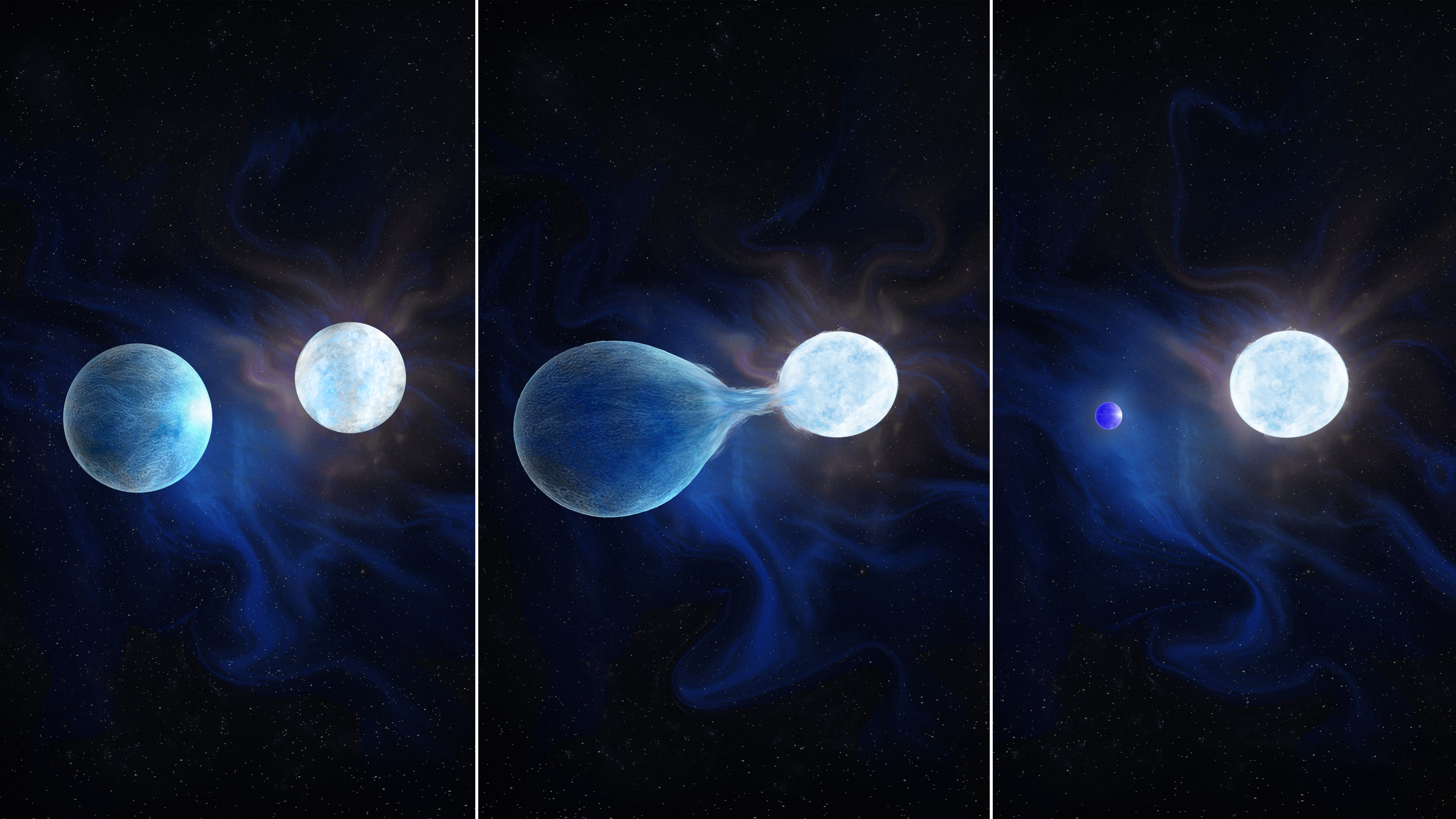
Astronomers have discovered 25 stars in two satellite galaxies of the Milky Way that have had their hydrogen-rich outer layers stripped away by a binary companion, leaving them as exposed helium stars. The hydrogen-stripped stars represent the progenitors of a special type of supernova — an explosion that occurs when massive stars die and birth black holes or neutron stars — and fill in a glaring hole in our understanding of some of the universe's most powerful events.
When massive stars die in bright supernova explosions, they often outshine the combined light of every star in the galaxy around them. Some of these events lack evidence of hydrogen, so it follows that they must begin with stars that also lack hydrogen in their outer layers. Until now, evidence of these hydrogen-stripped stars has largely eluded scientists.
This is the first time a population of these hydrogen-stripped stars has ever been discovered.
"We've known for a decade or two that almost all massive stars are actually in binary systems, and one in three is close enough to undergo this process where the hydrogen envelope should be removed by the gravitational influence of the other star," Maria Drout, an assistant professor in the Department of Astronomy and Astrophysics at the University of Toronto and co-author of a new study on the stars, told Live Science. "The universe only made sense if these stars existed and were very common. However, only one candidate system was known until we did our study, so it was really a big problem."
With the discovery of these hydrogen-stripped stars in the Large Magellanic Cloud (LMC) and the Small Magellanic Cloud (SMC) — two small galaxies that orbit the Milky Way, and the closest galaxies visible to Earth beyond our own — the astronomers can finally begin to correct this imbalance, helping to confirm models of stellar evolution. The team's research was published in the Dec. 14 edition of the journal Science.
How hydrogen-stripped stars stayed hidden
Hydrogen-stripped stars have been so evasive because the removal of their outer layers leaves them as incredibly hot, exposed stellar cores, Drout said. This means they emit most of their light in the ultraviolet region of the electromagnetic spectrum, beyond the range visible to human eyes.
Ultraviolet light is difficult for ground-based telescopes to observe because it is strongly absorbed by our planet's atmosphere. Ambient dust in the Milky Way absorbs even more of this light, making hydrogen-stripped stars nearly impossible to detect. However, our view of satellite galaxies like the LMC and SMC is much clearer for space telescopes outside Earth's atmosphere.
The team discovered the population of stripped stars in data from the Swift Ultraviolet/Optical Telescope, which has observed millions of stars in the LMC and the SMC from its position in low Earth orbit.
The researchers then confirmed the stars as hot, hydrogen-poor, exposed stellar cores in binary systems using the Magellan Telescopes at Las Campanas Observatory in Chile between 2018 and 2022. While astronomers already knew that massive stars prefer life with a stellar companion, this discovery confirms what that social life looks like as those binary systems age.

The social lives of massive stars
Just as the sun will swell up as a red giant star when it runs out of hydrogen in its core in around 5 billion years, massive stars undergo a similar swelling transformation into red supergiant stars when they exhaust the hydrogen in their cores, Drout said.
"If you have two stars that are in a binary and one of them starts to expand, pretty soon, the outer part of that star ends up getting stripped, meaning you can end up with a star with basically no hydrogen left on it," she said. "So we have this process where the binary stars interact and dance with each other and exchange mass and material, and that really affects the rest of their lives dramatically."
While Drout and the team theorize that the 25 newly discovered stars will eventually erupt as hydrogen-poor supernovas, she concedes that astronomers won't be waiting around for this to happen.
"We think we understand what evolutionary stage these stars are in, and they are fusing helium in their cores, meaning they are quite evolved," Drout said. "But that means it will still probably be a million years before these particular stars explode."
When this eventually happens, the team thinks a small sample of the systems they have observed will become something very special. If the supernova creates a neutron star and doesn't push the companion star away, the transfer of matter between the stars could switch. Then, the star that once fed on the now-dead star would begin to lose its hydrogen-rich outer layers to the pull of its new neutron star companion.
This could result in a second hydrogen-poor core-collapse supernova in the binary and thus a system with two neutron stars orbiting each other. As these binary neutron stars spiraled around each other, they would lose angular momentum through the emission of gravitational waves, eventually leading them to merge and send out a flash of light called a kilonova.
To further study these stars and see which are possible kilonova progenitor systems, the team will turn to the Hubble Space Telescope, the Chandra X-ray Observatory, the Magellan Telescopes, and the Anglo-Australian Telescope. Additionally, they will search for hydrogen-stripped stars in other galaxies and within the Milky Way.







